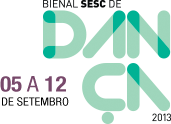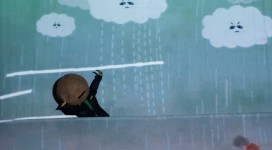blog_ 7x7
MARIA CLARA VILLA LOBOS x ARTHUR MOREAU = for children, but not much.
By Arthur Moreau around Têtes à Têtes, by Maria Clara Villa Lobos.
The dance of two big heads (Berthélémy Manias Valmont and Maria Clara Villa Lobos) that show through an allegoric narrative some stages of life is for children of all ages.
From beginning to end, it includes projections that often appear in a way to determine the expressions of the characters, each representing a gender. The possibility of transsexuality or of plural genders is excluded from the story. Têtes à Têtes presents a generalist narrative whose esthetic didactics presents a heteronormativity pattern. This is a pity because the younger the person the easier it is to teach what is out in the world and stimulate the healthy and humanistic interaction potential.
However, there are many delights in Maria Villa Lobos’ enactment. The comic aspect WORTH EXPLAINING goes through all the presentation without interfering with the plot and without ignoring the phenomena of the nature we have to live with, even if occasionally. The goof-ups, the freshness of experiences, the beginning of the sensibility of identification with one’s own body, the awe in face of the other and of one’s own capacity and incapacity are often funny actions that cause empathy – even more when those who watch have it all fresh in their memory. The charismatic provocation of surprise remains in a tone that places our attention close to the sequence of happenings and its unfoldings. In a nutshell, the laugh is such that it doesn’t get in the way of the perception of the narrative and affective line.
Beings are born, they feel lonely, they eat, shit, fart, their bodies change, many get laid and others procreate and all die. However, to express these among other personal happenings without using words sensitizes indicial communication better. The top quality projection makes a good match with the quality of movement and the agility of the pair Valmont and Villa Lobos. The dancers follow the animation film or react to it. Chronometry is fundamental in this choreography. This efficiency is sided by the characters’ communicational interpretation. Their innocence, fragility and curiosity force the balance of their bodies agility, speed and relaxation, even if their faces can’t be seen. The big heads are discovering the world and its colors, their bodies and their senses. It’s the vigor of fickle discovery.
As dance serves senses better and Têtes à Têtes wishes to tell a story, a phenomenon better ruled by meanings, many times the characters made a situation clear in a banal way. This choice sometimes slows down the speed of more dynamic, instigating and inviting moments of the scenes. It is as if language games almost happened effectively through the bodies painted by the projections. However, they are slowed down by hints to make what’s being told redundant just to ensure the information of facts that are happening to the big heads. Constantin Stanislavski (1863 —1938) already said once: “Children’s theater must be like adult theater, only better”.
Arthur Moreau is an artist, Bachelor in Communication of Body Arts from PUC-SP and a graduate student of Philosophy at USP.
Translation Portuguese-English: writer and poet Chris Ritchie, M.A.

